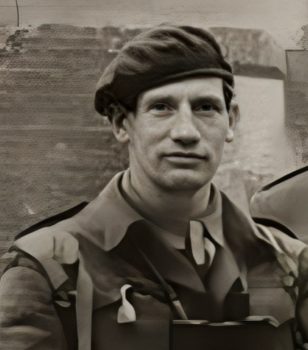
Stood first on the left is Lieutenant George Herbert DCM MM of No. 3 Commando. Herbert, who was awarded the Military Medal for gallantry at Dunkirk, was one of the most courageous soldiers of the Second World War.
On his return from France, he volunteered for the Commandos but soon found himself in front of his commanding officer, Lieutenant Colonel John Durnford-Slater, for a charge of ‘conduct to the prejudice of good order and military discipline, i.e. fighting in the billets’.
However, Durnford-Slater saw the value in the man who ‘had had a hell of a battle in France and hadn’t fully unwound’ and spared him from the only punishment that struck fear into the men who volunteered for ‘special service of a hazardous nature’ – the dreaded ‘RTU’ – Return to Unit.
The CO’s judgement proved correct, and it was on the battlefield where George Herbert proved his worth. At Vaagso, Norway in 1941, as a Lance Sergeant during Operation Archery, he spotted a German soldier running towards a nearby hill, ‘in action nobody’s brain worked quicker than Herberts’ commented legendary commando leader Brigadier Peter Young DSO MC**, who was Herbert’s troop commander at the time.
Herbert quickly deduced that there was a shelter beneath the hill, ordered his men to cover him, and single handedly charged into the bunker. Inside he found a German commander complete with the Iron Cross on his chest and fifteen men which he duly captured. For his ‘great determination, leadership, and personal gallantry’ George Herbert was awarded the Distinguished Conduct Medal.
In Sicily in 1943, during Operation Husky shortly after he received his commission, he led the charge through a ‘series of violent battles’ taking out one machine-gun post after another until he was knocked unconscious by an exploding grenade. With blood pouring from his ear those who witnessed it thought he was ‘done for’. But not Herbert, John Dunford-Slater recalled how within ten minutes ‘he was on his feet and leading the advance in his usual fighting, forceful style’.
Fortunately for Durnford-Slater he had a man who was as tough as teak by his side, on one occasion on the same operation the CO went forward to engage an enemy truck that had just been set a light by the commando’s gun fire. But to his surprise ‘a huge German came out, roaring with righteous indignation’ and caught him off balance. Luckily for the CO, Herbert was at hand and killed the German with a single shot fired from the hip.
In 1944 George Herbert landed with No. 3 Commando on Sword Beach on D-Day and took the fight to the enemy. Tragically it was to be his last foray. John Durnford-Slater, who considered Herbert to be the ‘perfect example of soldier, officer and gentleman’, as well as a close friend and adviser, described his last feat of courage, ‘George Herbert was killed personally leading a determined and successful counter-attack. He was last seen advancing, roaring like a lion, firing a Bren-gun from the hip, knocking the Germans left, right, and centre, until finally he himself was shot through the heart.’
Lieutenant George Herbert DCM MM, who was described by Peter Young as ‘a fighting man in a class by himself’ was killed in action on 8th June 1944 and is buried at the Ranville War Cemetery, Normandy, France.


